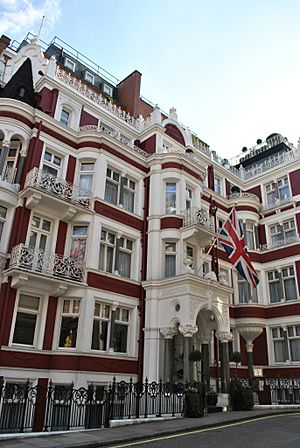Maria Howard, Duchess of Norfolk facts for kids
Maria (Mary) Howard (born around 1693, died 1754) was an important English noblewoman. She was the last person from the rich Shireburn family. Maria married twice. Her first husband was Thomas Howard, the 8th Duke of Norfolk. Later, she married Peregrine Widdrington. Maria built a house in London that is now a famous club called the Royal Over-Seas League.
Maria's Early Life
Maria Shireburn was born in London around 1692 or 1693. She was the only child of Sir Nicholas Shireburn and Catherine Charleton. Her family was very well-known and Catholic. Maria grew up mostly at Stonyhurst Hall in Lancashire, which is now Stonyhurst College. She was christened Maria Windforda Francesca but was always called Mary.
When she was young, Maria had poor health. In 1698, she traveled to France to visit the Jacobite court. This was where supporters of the former King James II lived. There, she was treated by James II's doctor.
Maria became the Duchess of Norfolk when she married Thomas Howard, 8th Duke of Norfolk on May 26, 1709. She was only sixteen years old. She brought a large dowry, which was a lot of money (more than £30,000) given to the husband by the bride's family. Even though Catholics were not allowed to marry publicly at the time, her wedding dinner was a very fancy event.
Her Marriages and Homes
Maria and her first husband lived in several grand homes. These included Arundel Castle in West Sussex and Worksop Manor in Nottinghamshire. They also had a house in London.
In 1722, her husband faced trouble because he was suspected of being involved in a Jacobite plot. He was put in the Tower of London. Maria was not allowed to visit him. However, she managed to get a relative, Charles Howard, 3rd Earl of Carlisle, to help him get out on bail in 1723.
Maria and her husband did not have any children. Their marriage was said to be unhappy. Maria had strong Catholic and Jacobite beliefs. Jacobites were people who supported the old royal family. Her husband may have wanted to hide these beliefs for political reasons.
By 1730, Maria was living apart from her husband. She felt he had given in to the new king, George I. Another reason for their separation was money. After her mother died in 1728, Maria inherited money from the Stonyhurst estate. But by 1730, her husband had taken control of it. He sold many things and moved others, leaving Maria with only her jewelry and some silver.

Maria's first husband died in 1732. In November 1733, she married Peregrine Widdrington. He was the brother of William Widdrington, 4th Baron Widdrington, who had taken part in a Jacobite uprising in 1715. Their marriage was announced in a magazine but not recorded in a church. This suggests they were married by a Catholic priest. This choice might have helped Maria keep her financial independence after the problems in her first marriage.
Maria decided to build a new house in London. She bought land on Arlington Street in 1734. She hired a famous architect named James Gibbs to design it. The house was finished in 1740. Today, parts of the house are still standing and serve as the clubhouse for the Royal Over-Seas League. Peregrine Widdrington died in 1748.
By this time, Maria was managing her northern estates from London. She continued to support Jacobite ideas but was not involved in the uprising of 1745.
Death and What She Left Behind
Maria Howard died in 1754. She was the last person in the Shireburn family line. She left behind property in several places, including Lancashire, London, and the Isle of Man.
A special set of 34 silver-gilt pieces, made in 1708, was given to Maria by her father when she married. This valuable set was worth £1,380,000. In 2012, it was allowed to be sent to Australia, even though the Victoria and Albert Museum wanted it to stay in England.

